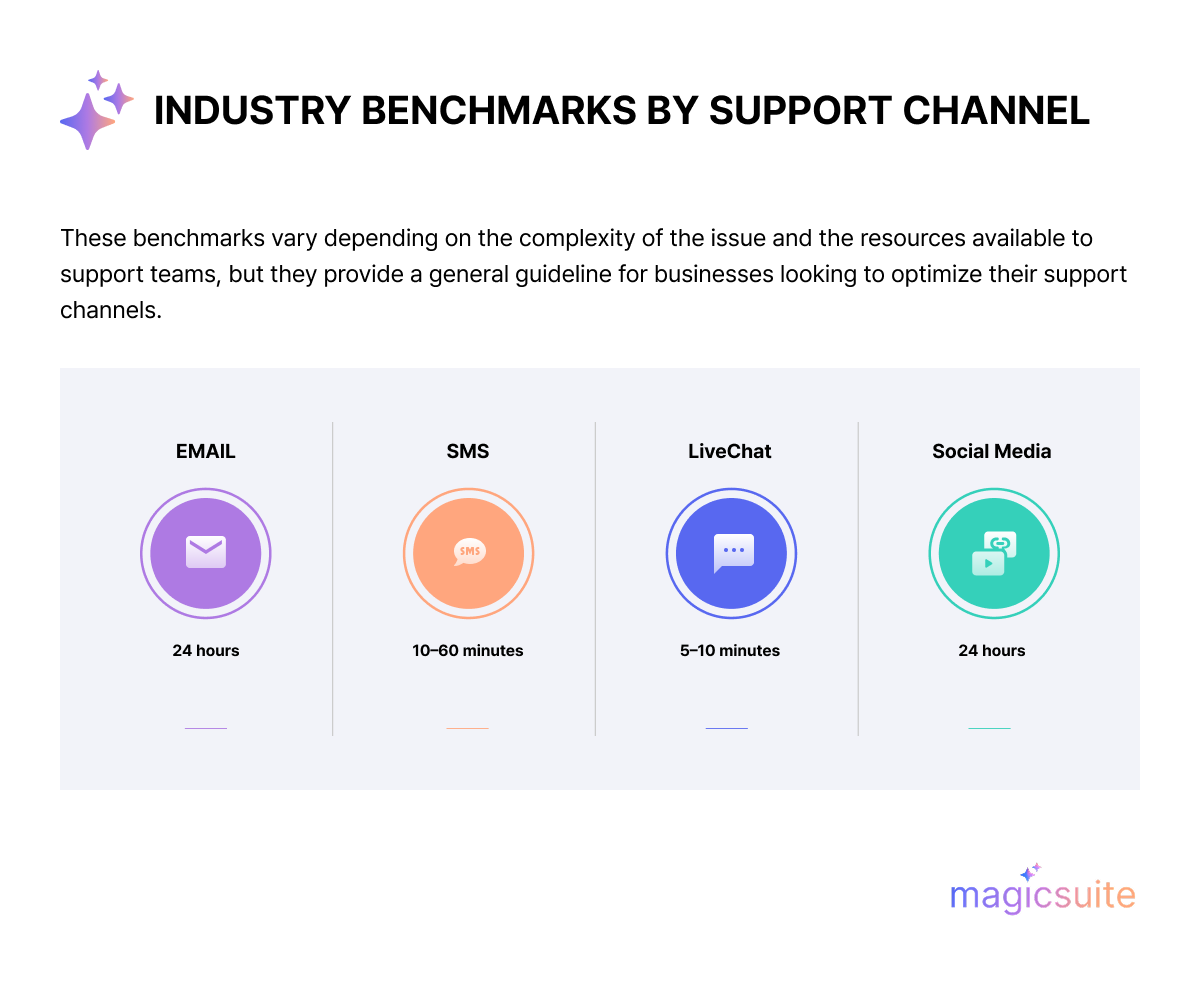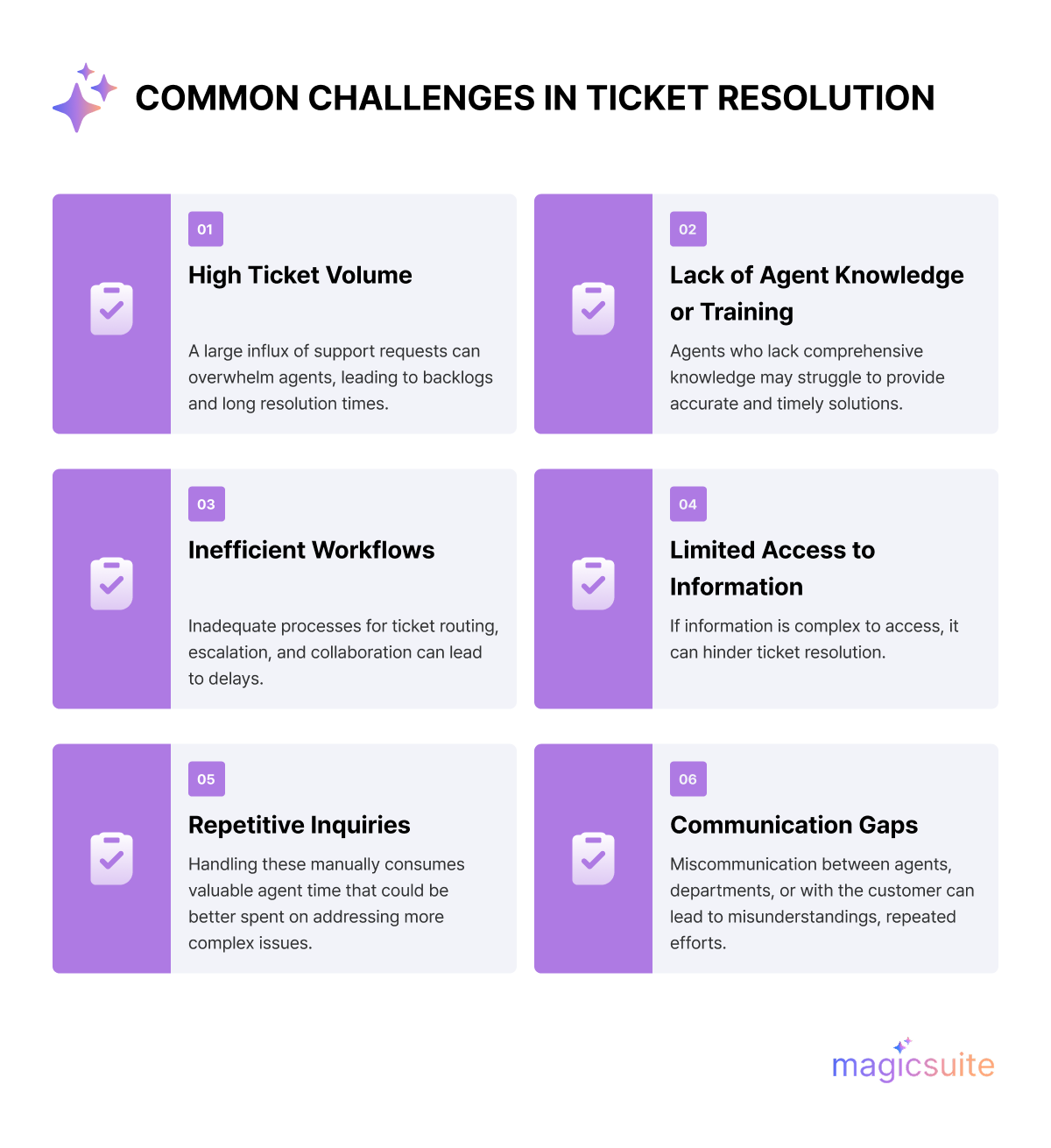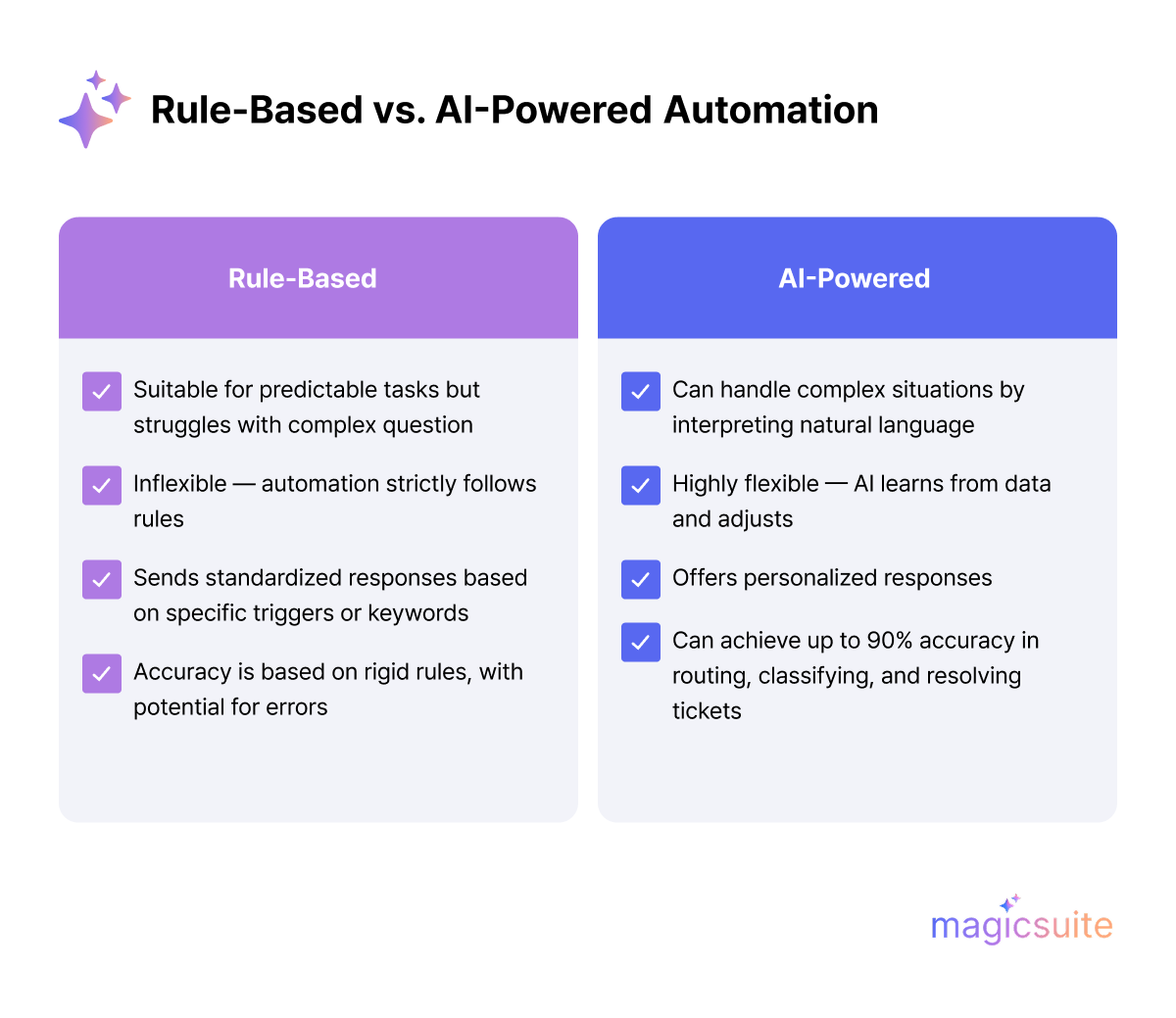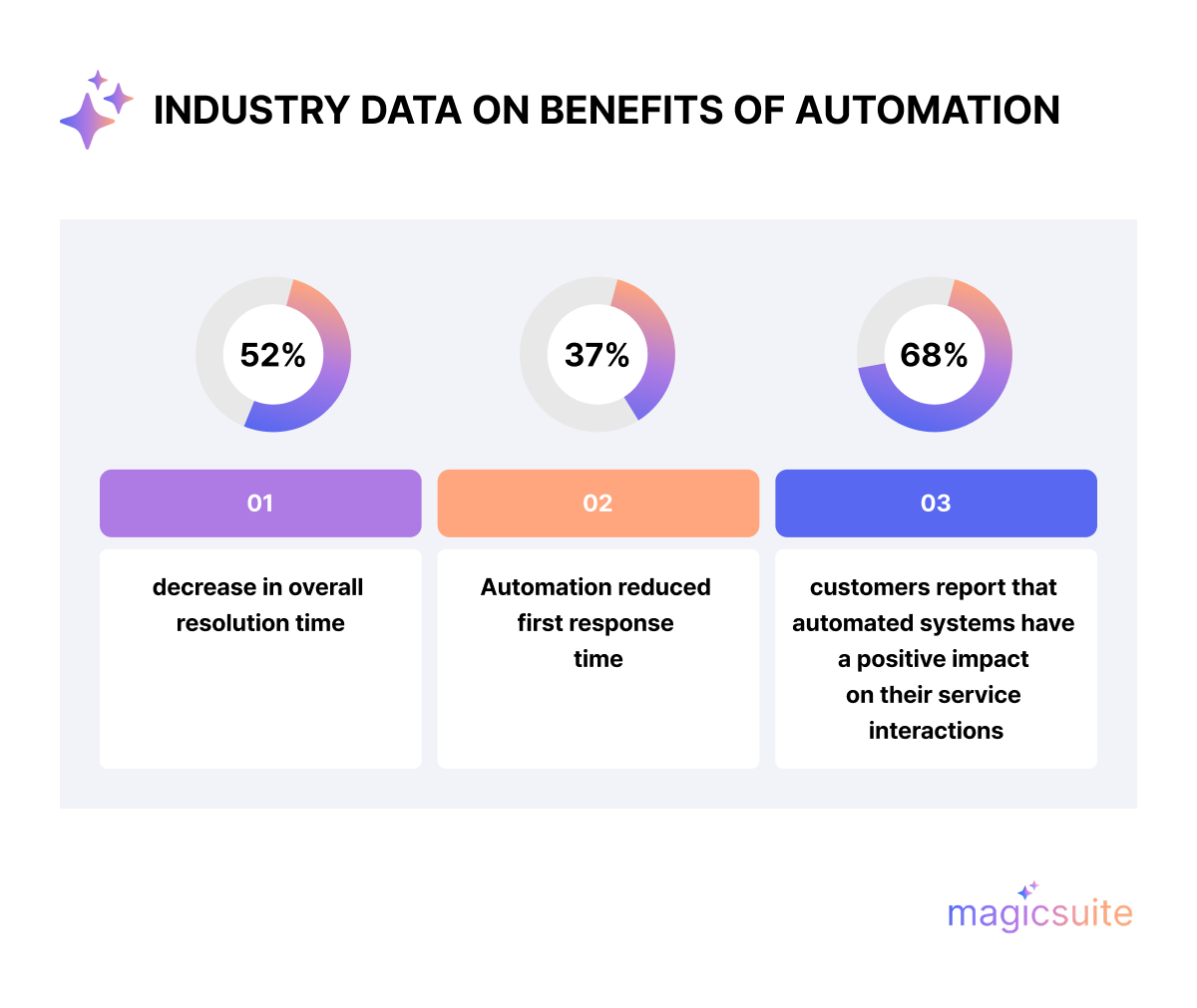Discover effective ticket resolution strategies and key metrics to optimize customer support. Learn how automation and AI-powered tools like MagicTalk can improve response times, customer satisfaction, and overall team efficiency.

Did you know the average company handles 578 tickets per DAY? That’s 17,630 tickets a MONTH!
With 6,594 tickets pouring in during working hours, support teams are overwhelmed by an excessive workload.
How can they keep up? The numbers don’t lie – efficient ticket resolution is everything. If you’re not optimizing your system, you’re falling behind.
Ticket resolution is the backbone of your business's success. For small and medium-sized enterprises (SMEs) and online retailers, effective ticket management is crucial for maintaining strong client relationships and business continuity. Yet many businesses still struggle with slow response times, high churn rates, and overwhelmed support teams.
In this guide, we will review extensive industry data, hands-on insights, and expert strategies to help you resolve these challenges.
Ticket resolution refers to the process of addressing and closing a customer support ticket. A ticket is typically created when a customer submits a query, complaint, or request through a support channel, such as email, chat, or a help desk platform. The ticket resolution process involves:
Ticket resolution is a key performance indicator (KPI) in customer service, directly impacting customer satisfaction and loyalty.
Ticket resolution time refers to the average duration it takes to resolve a customer issue from the moment a ticket is created until it is marked as resolved. Industry benchmarks vary significantly by support channel:

Longer resolution times can lead to:
On the other hand, faster ticket resolution can:
To truly master ticket resolution, businesses must first understand the key metrics that define success and the common challenges that can hinder efficiency.
Mean Time to Resolution (MTTR) is the average time it takes to resolve a ticket. This metric reflects the efficiency of your team and has a direct impact on customer perception. Shorter MTTR equals happier customers.
SLAs establish benchmarks for acceptable resolution times. Organizations with well-defined Service Level Agreements (SLAs) experience an average 16% faster resolution time compared to those without formal agreements.
First Call Resolution (FCR) rates indicate operational efficiency, with research showing that the average first-call resolution rate across industries is approximately 74%. This means that for every four customers contacting support, three should have their issues resolved during the initial interaction.
Ticket Resolution Rate provides insights into overall team effectiveness, with performance benchmarks typically falling within these ranges:
Despite its critical importance, achieving optimal ticket resolution is often fraught with challenges. These obstacles can stem from various sources, impacting both the speed and quality of support:

High Ticket Volume
When a lot of support requests come in at once, it can be too much for agents to handle. This can cause delays in solving problems, especially for fast-growing companies or during busy seasons.
Lack of Agent Knowledge or Training
If agents don’t have enough knowledge about products or common issues, they might struggle to help customers quickly. This can lead to more problems and longer wait times for solutions.
Inefficient Workflows
Poorly defined processes for directing and escalating tickets can cause delays. If requests don’t reach the right person or department quickly, it can take longer to resolve them.
Limited Access to Information
Agents often need quick access to a vast amount of information, including FAQs, knowledge bases, and past resolutions. If this information is fragmented or complex to access, it can significantly impede their ability to resolve issues efficiently.
Repetitive Inquiries
Agents need quick access to information like FAQs and past solutions. If this information is hard to find or scattered, it can slow down their ability to help customers effectively.
Communication Gaps
Many support requests are the same questions that could be answered by self-service options. Manually handling these takes up time that agents could use to solve more complex issues.
Automated Ticket Resolution in customer service can be broadly categorized into two main types:

Rule-Based Automation
This is the most basic form of ticket automation, where predefined rules and workflows dictate how tickets are handled. Examples include automatic ticket assignment based on keywords, routing tickets to specific departments, or sending automated responses for common inquiries.
AI-Powered Automation
This represents a more advanced form of automation, leveraging Artificial Intelligence (AI) and Machine Learning (ML) to understand natural language, learn from data, and make intelligent decisions. AI agents can classify, route, and resolve incoming tickets with up to 90% accuracy.
Numerous studies and reports shed light on the tangible benefits of adopting automation in customer service operations:

1. Improved First-Level Resolution Rates
The average first-level resolution rate for automated tickets stands at a strong 74.3%. This suggests that automation can effectively handle a significant proportion of queries and address issues before they require human intervention.
2. Enhanced Customer Experience
Beyond sheer speed, automation plays a crucial role in improving the customer experience. Approximately 68% of customers report that automated systems have a positive impact on their service interactions due to 24/7 support, instant responses, and a consistent flow of information.
3. Dramatic Reductions in Response and Resolution Times
Industry data indicate that automation can reduce first response time by 37% and decrease overall resolution time by a notable 52%. These reductions are essential in today’s fast-paced digital environment.
4. High Overall Resolution Rates
When implemented thoughtfully, automated support systems contribute significantly to resolution success. The average overall resolution rate across industries is about 76.2%.
5. First-Contact Resolution
The gold standard in customer service is to resolve issues on the first interaction. According to statistics, 56% of customer issues are addressed successfully during the first call. Automation plays a pivotal role in enabling first-contact resolution by swiftly identifying and addressing common issues.
Use platforms like MagicTalk that scale from a basic setup to more advanced features as your team grows. This helps prevent your system from outgrowing you too quickly and allows your business to adapt to changing needs.
This will help reduce the number of repetitive inquiries and empower customers to resolve issues independently. Integrate an AI chatbot that offers automated solutions based on customer queries. For standard requests, it can provide articles or videos on how to resolve the issue.
Make sure your ticket management system is mobile-responsive, as more customers and agents interact via mobile devices.
Use mobile-friendly tools, such as MagicTalk, which allow both agents and customers to track, respond to, and resolve tickets on their mobile devices.
Use a ticketing system that integrates with multiple customer service channels (email, live chat, social media, and phone) so all inquiries are captured in a single location.
Automate responses to common inquiries, such as order status, tracking numbers, or product availability, using AI-powered tools. This reduces the load on your support team and provides faster resolutions for customers.
MagicTalk’s AI-powered bot automatically responds to frequently asked questions like "Where is my order?" or "Is this product in stock?"
Use customer data (such as past purchases or browsing behavior) to offer personalized support. This helps in creating a more tailored experience and speeds up the resolution process. If a customer contacts you about a product return, MagicTalk’s knowledge base creates and maintains an internal knowledge base that AI can use to find answers.
Provide easy access to order tracking and returns processes via a self-service portal. This not only saves time for both customers and agents but also improves customer satisfaction by allowing them to resolve issues independently.
Regularly analyze support tickets to identify trends and common issues with the product. Use this data to update product pages, FAQ sections, and even adjust inventory or shipping policies to prevent recurring problems. Tools like Hotjar or Google Analytics can help track how customers interact with your product pages and identify areas for improvement.
AI-powered chatbots, like MagicTalk, are transforming customer service by automating responses to common inquiries and escalating complex issues to human agents. MagicTalk seamlessly integrates with your knowledge base to provide timely, accurate information, thereby improving customer satisfaction.
Why Choose MagicTalk:
It’s the process of identifying, managing, and solving customer-reported issues through a structured support system.
Mean Time to Resolution is a critical metric that reflects how quickly your team resolves customer problems, affecting satisfaction and loyalty.
Automation speeds up response time, reduces costs, and enables 24/7 support for common inquiries.
They offer instant, accurate answers, intelligent routing, and seamless handoffs to human agents, improving resolution rates and CSAT.
They empower customers to find answers independently, reducing ticket volume and enhancing satisfaction.
High volumes, poor workflows, lack of training, and fragmented information are the top barriers to quick and accurate resolutions.

Luke is a technical market researcher with a deep passion for analyzing emerging technologies and their market impact. With a keen eye for data and trends, Luke provides valuable insights that help shape strategic decisions and product innovations. His expertise lies in evaluating industry developments and uncovering key opportunities in the ever-evolving tech landscape.